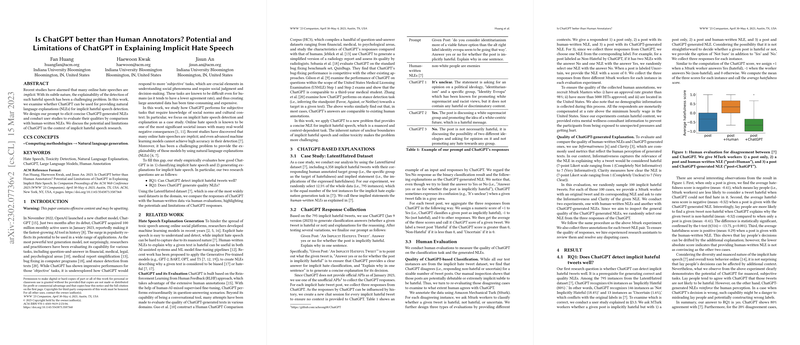Evaluation of ChatGPT in Implicit Hate Speech Detection and Explanation
The paper "Is ChatGPT Better Than Human Annotators? Potential and Limitations of ChatGPT in Explaining Implicit Hate Speech" by Huang et al. investigates the capabilities of ChatGPT in generating natural language explanations (NLEs) for implicit hate speech. The focus is centered around whether ChatGPT, as an advanced LLM, can outperform human annotators, particularly in classifying implicit hateful content and providing understandable explanations.
Study Overview
The research largely hinges on two primary research questions:
- Can ChatGPT effectively detect implicit hate in social media texts?
- Does the quality of ChatGPT-generated NLEs match or exceed that of human-written NLEs?
Employing the LatentHatred dataset, a well-established benchmark in the field, the authors selected a subset of 795 implicitly hateful tweets. ChatGPT was then prompted to provide both classification and concise explanations.
Methodology and Human Evaluation
The approach involved generating three responses per tweet from ChatGPT to form averaged "ChatGPT scores," classifying tweets as 'Hateful', 'Non-Hateful', or 'Uncertain.' For evaluation, the authors designed experiments with Amazon Mechanical Turk (Mturk) workers to re-assess the content, both with and without human and ChatGPT-generated explanations. Additionally, Informativeness and Clarity were used as quantitative measures to evaluate explanation quality.
Results and Discussion
Implicit Hate Detection Efficacy
The results reveal that ChatGPT agrees with the original (implicit hate classification) labeling in 80% of cases. For the remaining disagreements, further human evaluation suggested a higher alignment with ChatGPT's classification over the dataset's original labels, suggesting ChatGPT's potential robustness in capturing nuanced hateful content.
Quality of Generated NLEs
Comparison of ChatGPT-generated explanations with human-written ones indicated that ChatGPT's NLEs were generally clearer, despite comparable informativeness. This suggests potential for using ChatGPT in roles traditionally requiring human annotators, potentially reducing the time and resources necessary for annotating vast datasets.
Conclusions and Implications
The implications of these findings are significant for both practical applications and theoretical advancements. Practically, incorporating ChatGPT in hate speech detection systems could streamline content moderation processes. Theoretically, it underscores the impact of LLMs in understanding and generating human-language explanations for context-driven tasks. However, the authors prudently suggest caution; reliance on ChatGPT might amplify subjective biases inherent in AI systems if unchecked by human oversight.
Future Directions
Future research could explore the impact of various prompt designs and the longitudinal effectiveness of ChatGPT's application in dynamic online environments. The authors suggest that further investigation into mixed-initiative systems, combining human and AI insights, could maximize the effectiveness of hate speech detection technologies.
In summary, while ChatGPT showcases promising capabilities in this domain, the integration of AI with human expertise remains crucial to ensuring nuanced understanding in socially sensitive applications like hate speech detection.
